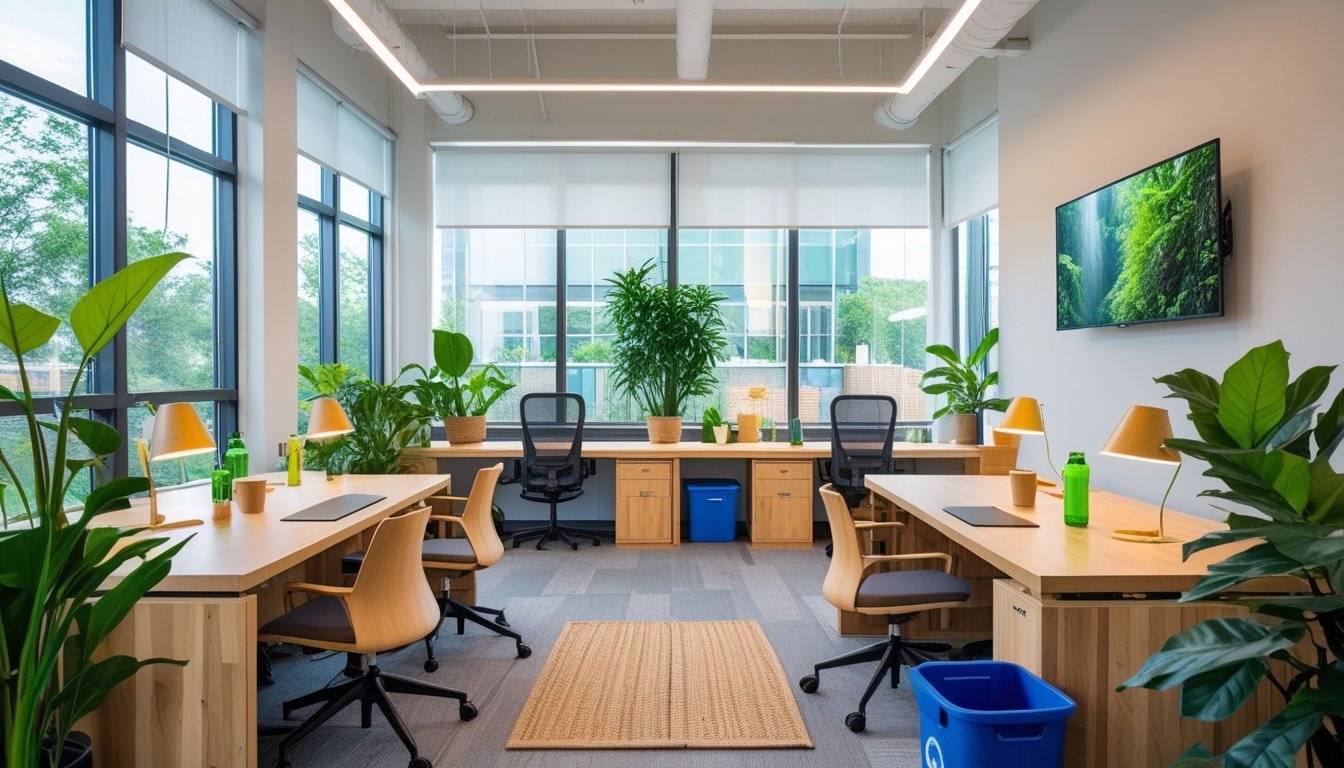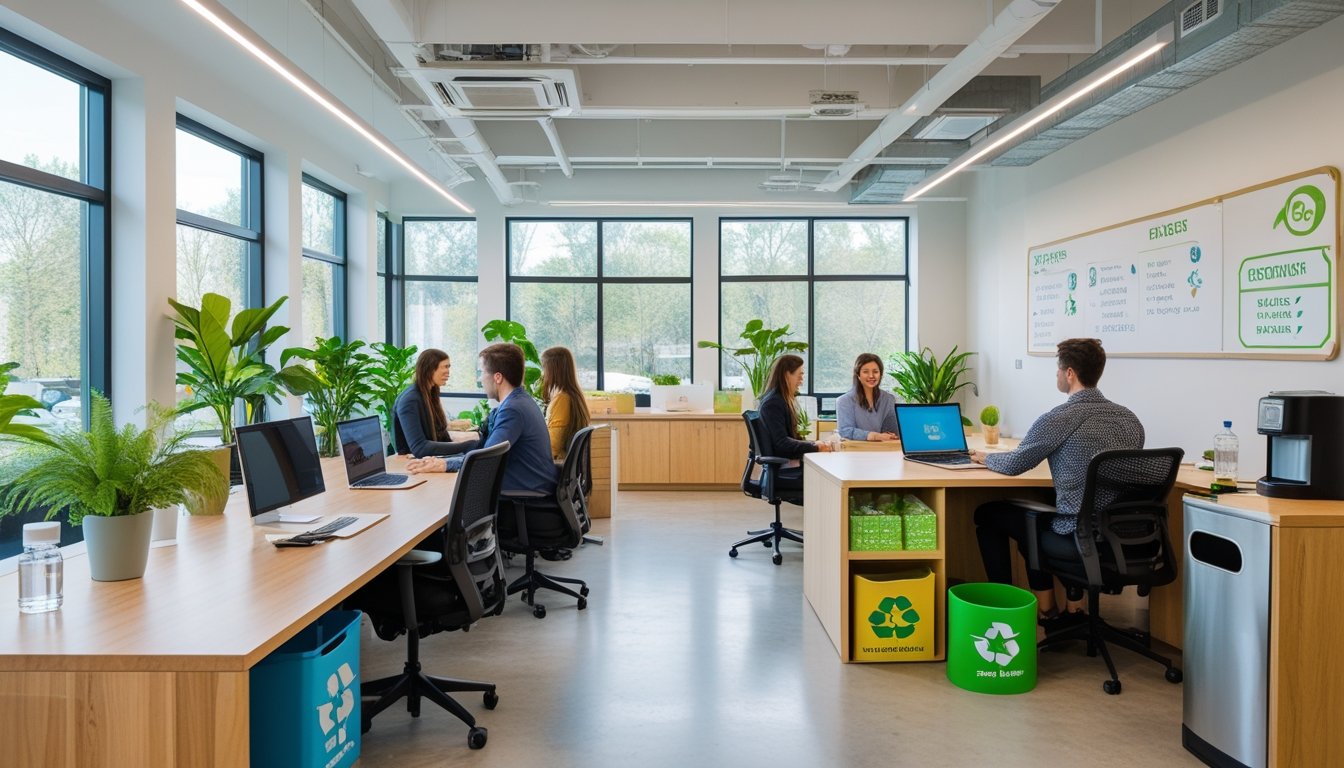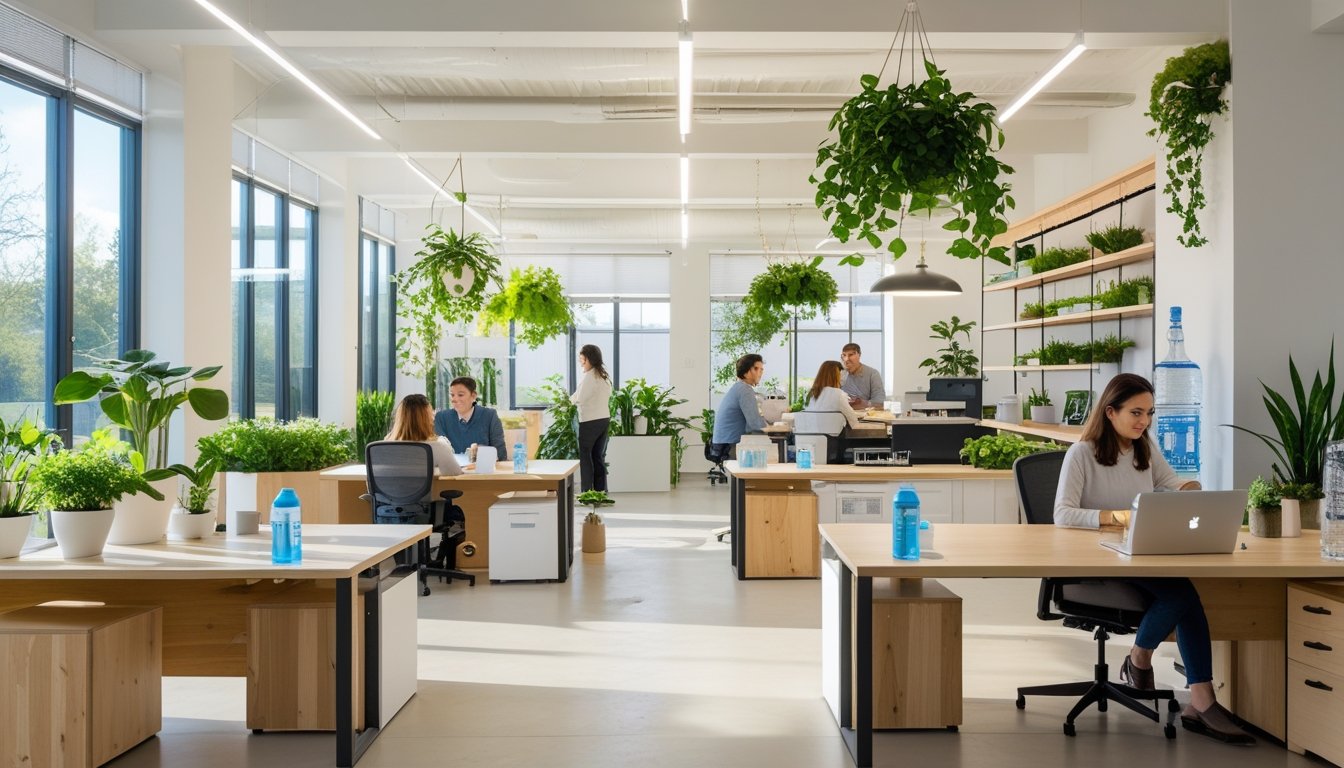Late updated: 17 May 2025 13:05
Written by: Sarah Hollister
Tips for Creating an Eco-Friendly Shared Office Space: Maximising Sustainability and Efficiency
Creating an eco-friendly shared office space is an essential part of modern sustainable practices that we can't afford to overlook. Implementing sustainable practices not only supports the environment but also enhances productivity and employee well-being. As we navigate the complexities of creating eco-friendly workspaces, focusing on strategies like reducing paper usage, using sustainable materials, and optimising energy efficiency can bring meaningful changes.

Incorporating green practices in our daily office activities is crucial to building a sustainable work environment. From adopting a culture of eco-awareness to integrating energy-efficient technologies, there are numerous ways to make our shared spaces greener. Simple actions like using LED lighting and choosing recycled office supplies can significantly reduce our carbon footprint.
As more of us seek sustainable solutions, it's imperative to explore practical steps and innovations that can transform our workplaces. By fostering eco-friendly habits and ensuring seamless integration of sustainable amenities, we can set a remarkable precedent in the arena of green workspaces.
Key Takeaways
- Sustainable practices enhance productivity and well-being.
- Daily actions in the office impact our carbon footprint.
- Green habits in workplaces can lead to meaningful change.
Fundamental Strategies for an Eco-Friendly Shared Office Space
In creating an eco-friendly shared office space, embracing sustainable design and architecture becomes essential. Implementing energy-efficient practices and incorporating renewable energy solutions further enhances environmental stewardship.
Prioritising Sustainable Office Design
Sustainable office design begins with selecting materials that are recyclable and non-toxic. Using reclaimed or locally sourced wood for furniture and fixtures reduces environmental impact. The layout should encourage collaboration while allowing for individual workspaces.
Flexible design is integral, enabling easy reconfiguration without waste. Reducing paper usage through digital communication and data storage also promotes sustainability. Incorporating plenty of indoor plants not only improves air quality but adds visual appeal and offers a sense of well-being. Their natural air-purifying qualities make them a valuable addition to any eco-conscious workspace.
Maximising Natural Lighting and Energy Efficiency
Natural lighting not only decreases dependence on artificial lights but also enhances productivity. Installing large windows and skylights can maximise daylight. This strategy must be complemented with energy-efficient LED lighting systems to use when natural light is insufficient.
Motion-sensor lights ensure energy is not wasted in unoccupied areas. In tandem, energy-efficient appliances such as computers and air conditioning units contribute to reduced utility costs. We can further improve thermal efficiency by installing smart thermostats that adjust temperatures based on occupancy and external weather conditions.
Incorporating Renewable Energy Solutions
Integrating renewable energy solutions like solar panels dramatically cuts reliance on non-renewable sources. Solar panels, positioned either on rooftops or other available spaces, generate clean electricity that can power the office and reduce carbon emissions.
Additionally, using green energy suppliers ensures a more sustainable energy footprint. Encouraging employees to use environmentally friendly commutes, such as bicycles or public transport, also supports this green initiative. By investing in renewable energy, we safeguard the future while promoting an eco-friendly mindset in our shared office spaces.
Daily Practices and Amenities for Sustainability

To create an eco-friendly shared office space, it's essential to focus on daily practices that minimise waste, use sustainable materials, and incorporate elements that improve the environment. These efforts will not only reduce our ecological footprint but also enhance productivity and well-being for everyone using the space.
Implementing Recycling and Waste Reduction Systems
We must establish a comprehensive recycling programme. Providing clearly labelled bins for different types of waste such as paper, plastic, and glass encourages proper recycling. This helps minimise landfill contributions. Employees can be encouraged to bring reusable containers, reducing single-use plastics. By auditing waste output regularly, we identify areas for improvement.
In addition, offering incentives for reduced waste, like recognition or small rewards, can foster a culture of sustainability. Through these small yet impactful practices, we collectively contribute to a healthier planet.
Opting for Sustainable and Recycled Materials
Choosing materials made from sustainable resources or recycled content is critical. Furniture crafted from reclaimed wood, bamboo, or other sustainable sources supports environmental initiatives. Using recycled paper products for printers and copiers is another significant step.
Incorporating these choices into our purchasing policies, we ensure everyday operations impact the environment as little as possible. This conscious choice reflects our commitment to sustainability, helping us inspire others in our community to do the same.
Enhancing Indoor Air Quality and Green Spaces
To enhance indoor air quality, we incorporate natural elements into our office design. Implementing air purifying plants not only improves air quality but also adds aesthetic value. Plants like spider plants or peace lilies can be strategically placed to maximise benefits.
Encouraging some natural ventilation when weather permits also improves indoor air. Creating green spaces or designated areas for relaxation in or around our office helps reduce stress and boosts productivity. Through these thoughtful integrations, we foster an environment that not only respects nature but also enhances our daily work experience.
Frequently Asked Questions

In creating an eco-friendly shared office, businesses can adopt strategies that promote sustainability and reduce environmental impact. This includes minimising waste, enhancing energy efficiency, and encouraging sustainable transportation.
How can businesses promote environmental responsibility in a shared office setting?
Businesses can cultivate a culture of sustainability by organising workshops and seminars on eco-friendly practices. Establishing a sustainability team to oversee initiatives can also help integrate green practices into daily operations and create accountability.
What are effective measures for reducing waste in a shared workspace?
Implement recycling programmes and provide clearly marked bins to ensure proper waste segregation. Encouraging digital documentation over printing and using reusable items like water bottles and coffee mugs will significantly reduce wastage.
What strategies can be implemented to improve energy efficiency in a coworking space?
Installing energy-efficient LED lighting and smart thermostats can greatly reduce energy consumption. Additionally, setting devices and equipment to energy-saving modes and ensuring they are turned off when not in use can conserve energy.
How can one incorporate sustainable supplies and materials into a shared office environment?
Opt for furniture made from recycled or sustainably sourced materials. Use eco-friendly cleaning products and office supplies. Purchasing products with minimal or recyclable packaging can also contribute to sustainability efforts.
In what ways can shared office spaces contribute to sustainable transportation initiatives?
Organise carpools or encourage using public transport by providing subsidies or incentives. Facilities for cycling, such as bike racks and shower facilities, can also promote biking as an eco-friendly commuting option.
What approaches are there to inspire eco-friendly habits among office staff?
Creating monthly green challenges can motivate employees to adopt sustainable habits. Recognising and rewarding those who actively participate in green initiatives fosters a spirit of continuous improvement and communal responsibility.
